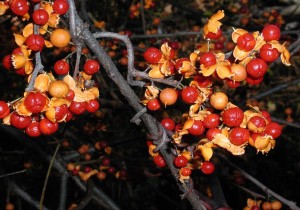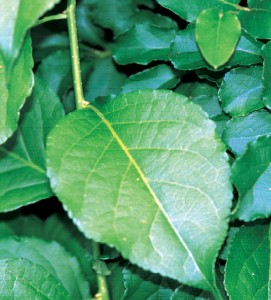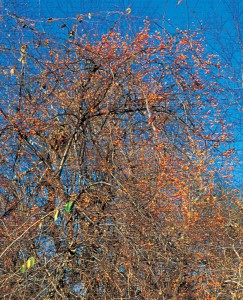Oriental Bittersweet
Celastrus Orbiculatus
Oriental Bittersweet
Native Origin: Also called, Asiatic/Asian bittersweet, this species is native to Korea, China and Japan. This deciduous, woody perennial vine was introduced from Asia as an ornamental, prized for its showy red-orange mature seeds. It unfortunately bears very close resemblance to, and can even hybridize with, our native American bittersweet, Celastrus scandens. Also producing showy fruits, native American bittersweet populations have been greatly reduced due to over-collection of vines for use in dried flower and wreath arrangements.
Description: Oriental bittersweet vines are light brown in color, two to four inches in diameter and up to 60 feet in length. Leaves are two to five inches long and are nearly as wide as long, making them nearly round. The glossy, finely toothed leaves alternate along the stem. Small, green-white flowers in clusters appear from May through June all along the vine near the leaf stems. Mature fruits open to show three seeds each covered in red-orange papery seed coats. While the two species are very similar in both appearance and habitat, American bittersweet has leaves that are oval and much less rounded. American bittersweet flowers and fruits only at the ends of the vines, rather than all along the vine. Before beginning control measures, great care should be taken to correctly identify and distinguish between the two species.
Ecological Effects: Oriental bittersweet aggressively invades forests, open woodlands, and forest edges. It grows through and over other vegetation, shading out and smothering herbaceous plants and kills trees and shrubs by blanketing them with foliage and girdling trunks, even uprooting trees by its massive weight. Because Asiatic bittersweet produces an abundance of fruits along the vine lengths, it is a prolific seeder; the plants also reproduce vegetatively through root suckering. Because it hybridizes with American Bittersweet, it is replacing an increasingly rare native plant.
Manual Control: Plants can be pulled, taking care to remove as much root as possible. If fruits are on the vines, all parts should be removed from the area and destroyed to prevent new growth.
Chemical: Systemic herbicides, such as glyphosate (Roundup) or triclopyr (Garlon) are effective controls. Herbicide take-up can be maximized by application onto cut stems.
Comments are currently closed.



